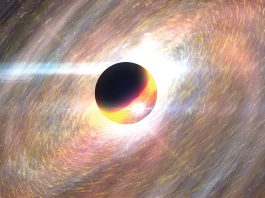Measurements attained by researchers at TU Wien indicate that new routes must be taken to identify materials that can be utilised as spin liquids.
‘Spin liquids’ are a hypothetical state of matter with magnetic properties. In theory, they could be utilised to transmit information without any electrons moving from its site. This would enable improvements for electronic components and potentially even quantum computers.
In recent years, there has been signs that spin liquids could exist in real materials, but to date, there has not been definite experimental proof of its existence.
New research indicates that spin liquids cannot form in a material that was formerly considered the optimal candidate. These results demonstrate that new routes must be taken in future research.
Technologies, whether a power cable or a semiconductor chip, are based on the transportation of electrical charge; electrons move, and information is transmitted by electrical signals – ‘charge’ versus ‘no charge’, or ‘current’ versus ‘no current.’
“This does not happen without loss,” explained Professor Andrej Pustogow from the Institute of Solid State Physics at TU Wien. “There is always a conversion of electrical energy into heat, or a loss of information.”
On top of its electrical charge, the electron has another significant property that can be utilised; this property is known as electron spin. Like a compass needle, the spin of an electron can be aligned with a magnetic field. For quantum physical reasons, the spin can only align in two different states: up or down.
“In a solid, an interaction can occur between the spins of neighbouring electrons,” said Pustogow. “One electron can pass on the orientation of its spin to the next one, and thus information is transmitted through the material without any particle ever moving from its site.”
Comparable to a metallic conductor whereby electronic charges move, this can be described as a ‘spin metal,’ whereby the alignment of the spins can propagate freely, but the charge – much like in an insulator – is stuck in place.
This phenomenon can only occur if there is no fixed spin configuration. In the event that a stable pattern – consisting of alternating spin-up electrons and spin-down electrons – is formed, then turning a spin around is energetically unfavourable and the spin structure remains rigid.
Consequently, in recent decades, scientists have considered the possibility of creating ‘spin liquids,’ whereby the spins do not produce a fixed pattern, but fluctuate and remain disordered so the spin orientation can move freely.
“You can imagine, for example, a material in which the electrons are arranged in a triangular pattern,” explained Pustogow. “If two electrons in this triangle occupy opposite spin states, the spin of the third electron must match one of these spins.”
A state in which all neighbours have opposite spin at the same time cannot be formed in such a triangular structure.
“Since 2003, an organic compound with spins on an almost perfect triangular lattice has been considered the prime candidate for a spin liquid,” said Pustogow.









